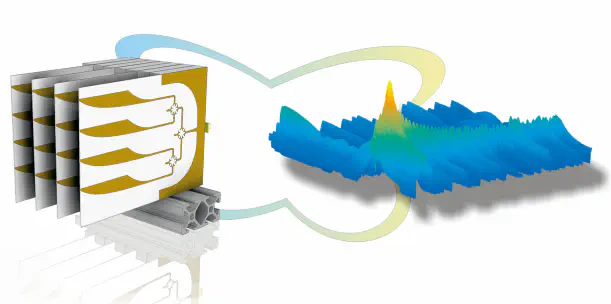Characterization and design of small array antennas for direction-of-arrival estimation for ultra-wideband industrial FMCW radar systems

Abstract
This thesis covers the characterization and design of small array antennas for ultra-wideband (UWB) industrial linear frequency-modulated continuous-wave (FMCW) radio detection and ranging (RADAR) systems. Although the techniques developed in this work are not limited to a certain application scenario, in particular the design of a four-element uniform linear and four-element uniform circular array antenna is considered. The antenna arrays are used for implementing direction-of-arrival (DOA) estimation in a novel UWB secondary RADAR system for industrial local positioning applications. The system’s frequency range is from 6 GHz to 9 GHz and hence possesses a relative bandwidth of 40 %. State of the art industrial FMCW RADAR systems in contrast traditionally operate in the narrowband regime with relative bandwidths much smaller than 10 %. In consequence methods traditionally used for characterizing the antennas, for modeling the influence of the an- tennas on the RADAR system performance, for implementing direction-of-arrival estimation in FMCW RADAR systems, and for designing antenna arrays are not sufficient. Their application to UWB FMCW RADAR systems is carefully reviewed, and where necessary extended to take into account effects emerging due to the large relative bandwidth. In particular an exact model for the received intermediate-frequency (IF) signal of a multi-channel UWB FMCW RADAR system employing an array of ideal point sensors is developed first. Approximations are then applied to the exact model until a suitable description for developing DOA estimation algorithms in the UWB FMCW RADAR system is achieved. It is further shown how this model is related to the narrowband models used for DOA estimation in traditional multi-channel FMCW RADAR systems. Subsequently refined beamforming algorithms based on the approaches of Bartlett and Capon, which take into account the received IF signal of the UWB FMCW sensor array, are proposed. Those algorithms are further extended to allow for simultaneous DOA and range estimation. A careful comparison of the refined algorithms with the traditional algorithms is used to demonstrate their superior performance in UWB FMCW RADAR systems. In addition it is shown that a sensor element spacing larger than the traditionally known limit may be used, which simplifies the design of UWB array antennas. The proposed models based on ideal sensor elements are then extended to take into account the simulated or measured characteristics of realistic antennas. Therefore, state-of-the-art methods for the characterization of isolated UWB antenna elements are used. Those methods are then refined to provide the necessary characterization of small array antennas, in particular including the effects of mutual coupling. Based on the antenna characterization, a simplified comprehensive model is developed which allows for taking into account the antenna array characteristics into the output of a multi-channel UWB FMCW RADAR system. This enables for directly assessing the influence of the antennas onto the performance of signal processing algorithms already during antenna development. Finally a four-element uniform linear and a four-element uniform circular array antenna are designed for the local positioning application. The linear array antenna employs a novel method referred to as column-coupling for achieving the desired characteristics in the frequency range from 6 GHz to 9 GHz. The circular antenna array is optimized for vehicle rooftop integration and is based on mechanically robust Monocone antenna elements.